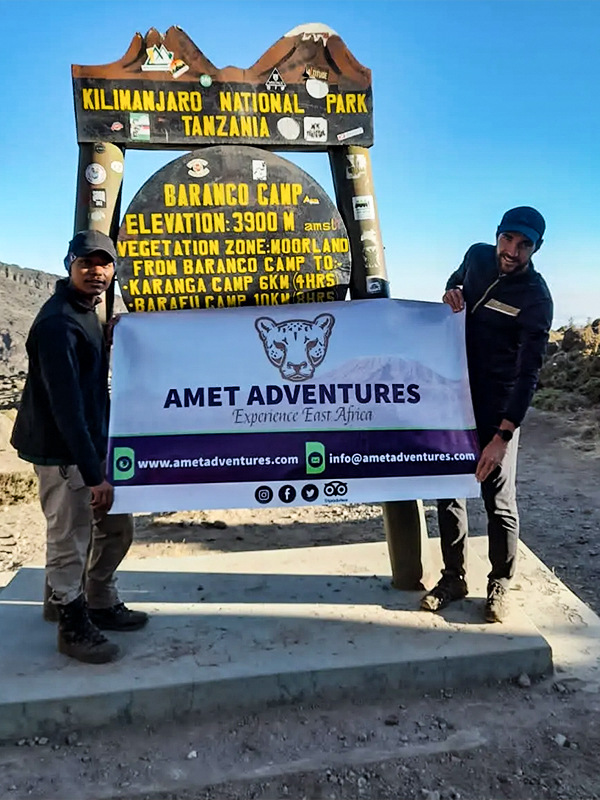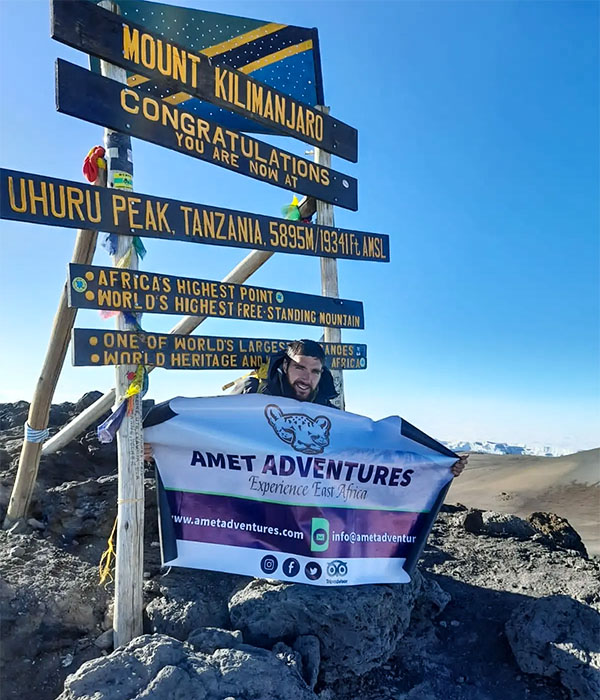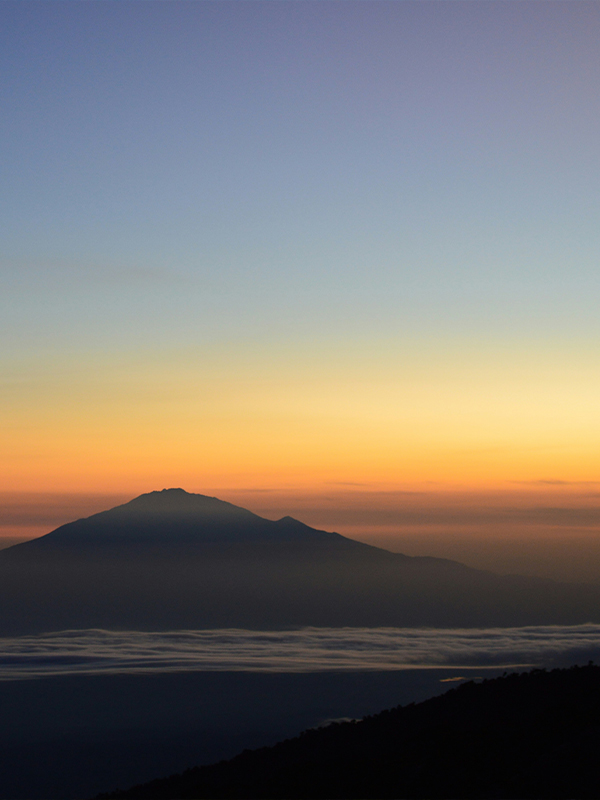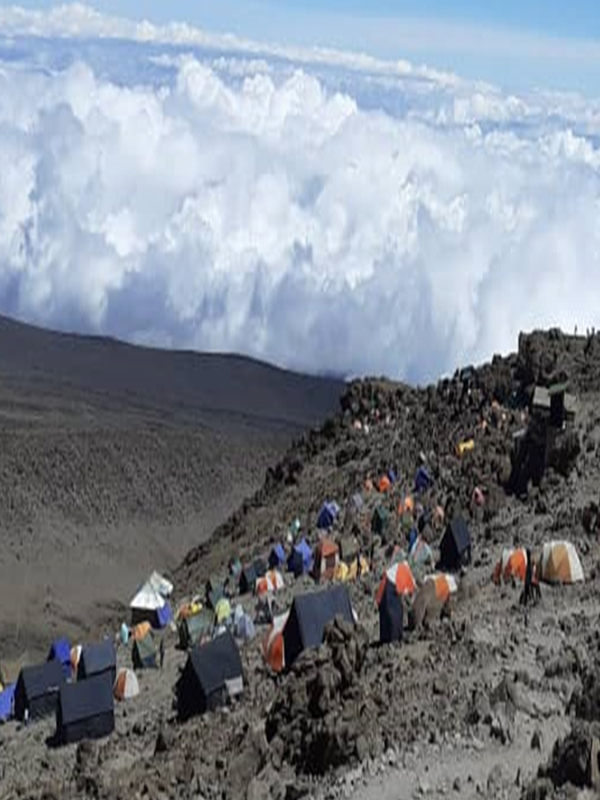Kilimanjaro Trek
Mount Kilimanjaro Overview
Mount Kilimanjaro is not only the tallest mountain in Africa, but also the world’s tallest free-standing mountain at an attitude of 5,895 meters (1, 9340 ft) above sea level and lies approximately 200 miles south of the equator in Tanzania.
The mountain is one of the seven summits bearing 3 major volcanic peaks namely, Mawenzi, Kibo, and Uhuru peak, with the latter being the highest peak.
Branded the roof of Africa, Mount Kilimanjaro can be climbed throughout the year and does not require technical skills to climb. There are 7 major established Kilimanjaro trek routes to Uhuru peak, and two descending routes, one via Mweka and another one via Marangu route.

Getting to Kilimanjaro
Mount Kilimanjaro is in Tanzania’s region called Kilimanjaro. The region is located in the northeastern part of Tanzania near the Kenyan border.
The mountain is assessable from the region’s capital called Moshi town, approximately 2- 3 hours drive to the starting point (Depending on the route you choose).
Many airlines offer direct flights to Tanzania Kilimanjaro International Airport (KIA) including KLM, Delta, Turkish Airlines, Emirates, Kenya Airways, Qatar Airlines, Ethiopian Airlines and Rwanda Air.
Due to the mountain’s proximity to Kenya, it is also possible to fly into Jomo Kenyatta International Airport in Nairobi, Kenya then you can connect to a shuttle bus from Nairobi to Moshi-Tanzania, approximately 8 hours drive.
Your pre and post Kilimanjaro trek accommodations in Moshi.
A day or two before and after Kilimanjaro trek is recommended in order to relax and perhaps sort out your trekking gears.
Our selection of accommodation facilities range from budget, and mid-range to standard options.
Here are some of our hotel selections;
Standard Hotel: Kiliwonders Hotel.
Mid-range hotels, Park View Inn or Panama Garden resort
Budget Hotels: Bristol cottages.

Best time for Kilimanjaro Trek
Kilimanjaro is accessible throughout the year but is best recommended in dry and warm seasons when the skies are clear for better views of the mountain and the weather.
However, the weather is quite unpredictable, and any weather condition can happen at any time of year, especially on the higher slopes.
There are two distinctive seasons that constitute the best time to climb Kilimanjaro. January up to mid-March and again from June to early October before the onset of the short rain seasons that begin in mid-October.
It is good to know that the season coincides with the summer holidays in Europe and America which attracts many trekkers if you prefer to avoid crowds, then March and early October before the onset of the rainy seasons would be the ideal idea.
May and November are wet months, and most western routes that include Lemosho, Machame, and Umbwe are not accessible due to heavy rains.
December is also a good month for Kilimanjaro trek but is characterized by a high level of snowfall. Rongai route is the only suitable option for people who would like to do Kilimanjaro trekking during the wet seasons.

Fitness and Training for Kilimanjaro Trek
The most effective training is hiking on hills and mountains regularly at least adopt a hiking program 2 months prior to your actual hike.
Train at least 3 times a week for one hour you can include weights on your daypack that you intend to use on Kilimanjaro perhaps 15-20 lbs.
A typical day during a Kilimanjaro trek will involve hours of walking at a slow pace it is, therefore, ideal to consider taking long walks instead of spending time in the gym.
For beginners, you can start with short distances without any weight and increase the distance gradually as your body becomes used to walking.
Remember during the actual Kilimanjaro trek you are going to pass through different climate zones which your body is not used to therefore alternating different trails and day hikes on hills at moderate elevations will make you better prepared for different attitudes on Kilimanjaro.
Where you may not have access to trails, hills, and mountains, climbing the stairs, or the use of a Stairmaster Machine with some weight on your day pack will work perfectly.
This is because you approach the hike dates you may need to prolong the distances and also create enough time to rest and sleep enough eat healthy avoid alcohol and smoking.

Gears and Clothing
Proper hiking gears and clothing are crucial for a successful summit of Africa’s highest mountain.
What items do you need in your day pack?
All the items you require for the day while on the mountain should always be packed in your day pack that you will be carrying on your back throughout the entire trek.
The duffel contains other items for the coming days and is always carried by the porters remember the porters are limited to curry 15kgs only.
Here is what you need to have in your day pack; All rain gear which includes a raincoat, poncho, rain trousers waterproof hiking boots, gloves and liners, Nalgene water bottles and bladders at least 3 litters, walking poles, a personal first aid kit and medication, energy bars and snacks.
Click the button below to check out our recommended Kilimanjaro trek complete packing list.

Kilimanjaro Trek Tipping Policy
Tipping your guides and porters on Kilimanjaro is a customary way to express your gratitude for their hard work and dedication. It’s a great way to show your appreciation for their efforts in ensuring a safe and memorable trekking experience.
For more detailed information on our tipping policy, including recommended amounts and best practices, please download our comprehensive guide.
Our preferred Kilimanjaro trek routes and Itineraries
7 Days Machame Kilimanjaro trek
Experience the scenic Machame Route, the second-most successful Kilimanjaro climb. Its “trek high, sleep low” approach aids acclimatization.
Experience the best Kilimanjaro trek on the popular Lemosho Route. Low traffic, stunning scenery, and a high summit success rate makes it the ideal choice.
Fly over Mount Kilimanjaro and admire its peaks, crater, and glaciers. This unforgettable flight also showcases Mount Meru and the Arusha region. A bird’s-eye view of breathtaking landscapes.
Kilimanjaro Climb Groups to Join
Climb Groups 2024
| Climb Dates | Route | Summit Occassion | Price | |
| 18th -24th December 2024 | 7 days Machame | Full Moon Summit | US$ 2200 | Inquire Here |
| 17th -24th December 2024 | 8 Days Lemosho | Full Moon Summit | US$ 2500 | Inquire Here |



